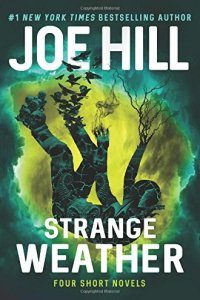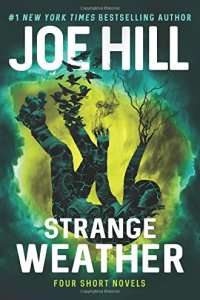Stefan Dziemianowicz Reviews Strange Weather by Joe Hill
 Strange Weather, Joe Hill (Morrow 978-0-06-266313-9, $27.99, 448pp, hc) September 2017.
Strange Weather, Joe Hill (Morrow 978-0-06-266313-9, $27.99, 448pp, hc) September 2017.
Strange Weather is Joe Hill’s second book of short fiction after his debut collection, 20th Century Ghosts. Or, to be more accurate, it’s his first collection of long short fiction. The book is subtitled “Four Short Novels” which will surely put those readers who measure Hill’s resume against that of his father, Stephen King, in mind of Different Seasons, King’s own second collection of four short novels. But there all comparisons end. Different Seasons was a compilation of what many readers, who were tone deaf to what King was attempting through his weird fiction, considered an unexpected detour into the literary mainstream. Strange Weather, by contrast, is as much as collection of imaginatively varied genre fiction as 20th Century Ghosts, and proof that Hill is currently one of our most accomplished writers of fantastic fiction at both shorter and longer wavelengths.
“Snapshot”, the book’s first story, hews closest to supernatural horror. It’s set in Cupertino CA in 1988 and its centerpiece is the relationship between Michael Figlione, its adolescent narrator, and his former babysitter, an elderly neighbor who appears to be in the disorienting throes of advancing Alzheimer’s disease. When she tells her caretakers that she’s trying to avoid “the Polaroid Man,” they all just assume he’s one of her enfeebled mind’s many delusions. But this is fantastic fiction, where the hypostatization of troubled states of mind, disordered emotions, and assorted anxieties and fears as figures incarnate is coin of the realm, and – guess what? – there is a Polaroid Man: a short-tempered, Cadillac-driving sharper who totes a specially souped-up Instamatic that preserves memories on photo stock by sucking them out of the person photographed. Michael tips to his game shortly after crossing his path and – in the best tradition of so many horror stories where kids (whose emotions are closer to our most basic fears) know that they have to find a way to dispose of the monster in our midst independent of any help from incredulous adults – catches him in a moment of vulnerability and delivers a just punishment. Many writers would have ended the story there, with its biter satisfyingly bit, but not Hill. Instead, the story goes on for a full quarter more of its length, allowing Hill to reflect, through the aftermath of those events, on how memory shapes our identities and how dependent we have become on our modern technology to serve as an adjunct to our own organic memories. It’s a nice grace note to what might otherwise have been a routine boogeyman story.
“Loaded”, the book’s second story, is also it’s sole non-fantasy. It opens in a St. Possenti FL town in 1993 with a scene meant to resonate with all-too-familiar contemporary news stories: a young black man being gunned down by police who mistake the CD case he’s clutching for a firearm. Fast-forward 20 years to 2012. A crime of passion acted out in a mall by a gun-toting woman newly dumped by her boyfriend goes south very badly when the mall security guard, acting on misinformation and his own shaky grasp of the situation, intervenes and winds up killing more people than the original shooter – including deliberately murdering the one witness who could shed light on what really happened to authorities. The security guard is lauded as a hero in the local press, but an investigative reporter (who was the ten-year-old companion of the young man shot in 1993) discovers that elements in his story don’t add up. The remainder of the tale is a suspenseful game of cat and mouse in which the guard’s increasingly futile efforts to cover up his crimes results in a final bloody act of desperation. Hill’s achievement here is his elaboration of America’s pervasive gun culture through the behavior of his characters and the types of tragedy it enables when domestic violence, racial insensitivity, and permissive laws all interact with it. The ending may surprise readers, although it shouldn’t, given how hauntingly it echoes the rhetoric spouted by politicians and pro-gun lobbyists in the aftermath of mass shootings.
“Aloft”, the book’s most inventive story, begins with a reluctant parachuter named Aubrey making his first jump and landing, somehow, on a totally solid cloud that supports his weight six thousand feet above ground. As Aubrey tries to understand this inexplicable phenomenon and find some way to escape from it, he discovers that the cloud is semi-sentient and eager to please him. It fashions a coat-rack from its substance for him to hang his clothes, it provides him with a banquet table of food (totally inedible), and it even conjures out of itself a female companion in the image of the woman for whom Aubrey has an unrequited crush for a few rounds of chilly and largely unsatisfying sex. It turns out that he and Harriet, the flesh-and-blood model for his cloud woman, were jumping to commemorate the memory of a mutual friend lost to cancer, and as Hill alternates chapters detailing Aubrey’s ordeal on the cloud and the history of his efforts to connect with Harriet, whom he refuses to accept he will never satisfy, it becomes apparent that Aubrey and the cloud have more in common which each other than perhaps Aubrey does with many of the people in his life. The story, which ends poignantly, is another fine example of Hill’s skill at using fantastic phenomena to explore essential humanity of his characters.
“Rain”, the book’s fourth and final novella, is a perfect segue from The Fireman, Hill’s 2016 novel about a near future in which the human race is imperiled by a pathogen that causes spontaneous combustion in those infected. Although apocalyptic in thrust, Hill’s novel was an intimate exploration of the good and bad ways that human beings respond to one another when confronted with the unthinkable. “Rain” works on a similar, if smaller scale. One morning in Boulder CO thunder clouds mass and the skies open up. What pours down isn’t rain but a deluge of needles, so sharp and driven that they rip the flesh from bones, destroy machinery, and ruin all but the sturdiest structures. Scientific theories abound for the cause of this meteorologic nightmare and Hill aligns his story with all of the nightmare scenarios extrapolated in contemporary news stories about the consequences of climate change and global warming: “The chemists and the geologists couldn’t come up with any natural process that could account for what happened – which meant it had to be the result of an unnatural process. Someone had figured out how to poison the sky.” Sure enough a man-made cause is discovered, but not before Hill treats the reader to a kaleidoscopic swirl of responses to the horror from religious cultists, rugged individualists, authoritarians, and a president in hiding tweeting out bilious accusations against our enemies. Also like The Fireman, “Rain” ends with the best possible testament to resilience and adaptability of our species to change and the durability of the human spirit when faced with the harshest conditions. It’s the one story in the book whose scope and development makes it feel more like a full novel than a long short story, but like the other three stories it provides the reader with characters, situations, and ideas with enough dramatic possibilities that longer novels could have been spun from them.
Stefan Dziemianowicz, Contributing Editor, is author of The Annotated Guide to Unknown and Unknown Worlds and a collection of re-told urban legends, Bloody Mary and Other Tales for a Dark Night, and editor (with S.T. Joshi) of three-volume reference work Supernatural Literature of the World: An Encyclopedia and of more than thirty anthologies including Bram Stoker Award-winning Horrors: 365 Scary Stories, Famous Fantastic Mysteries, and 100 Ghastly Little Ghost Stories. Between 1991 and 1999, he edited critical magazine Necrofile: The Review of Horror Fiction. His critical work on horror and fantasy fiction has appeared in Washington Post Book World, Lovecraft Studies, and other publications, and he is a regular contributor to Publishers Weekly.
This review and more like it in the January 2018 issue of Locus.





